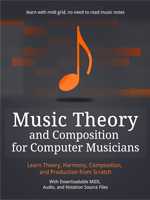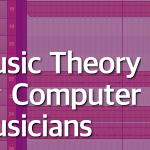In the previous part, we’ve learned the basics of music theory. Today we’ll learn about the rhythm and meter – quite important concepts in music composition. We’ll also discuss syncopation and accents in music.
2. Rhythm and meter
Now that you know notes, pauses and tempo, the final basic element of music theory is rhythm and meter. Let’s start with the rhythm. In itself, rhythm is a concept we all understand intuitively. It’s part of our human nature.
In case of music theory though, we discuss rhythm more in the context of how to notate it.
Rhythm is a way to vary the length of the notes in some organized way. In practice, rhythm is a number and/or form of accented fragments of the bar, and also the regularity or irregularity of the sound. To put it even simpler, rhythm is a pattern of pulsing sounds in a given time period.
The best way to understand this is by taking a look at some examples. Figure 2.1 shows the meter settings in Reaper, by default set to 4/4.
Now take a look at the rhythm in this meter (and listen to it in your DAW).
Figure 2.2 shows a simple rhythm in a 4/4 meter. The notes are played equally spaced, which creates a simple accented rhythm, meaning that some of the notes (the darker ones on figure 2.2) are played stronger, thus creating “accents” – they are more prominent this way. We can achieve stronger beats using “velocity”, which is one of the MIDI controls offered by DAWs and MIDI editors.
An accented note here (or a drum hit with greater force) creates so called “strong beat”, a part of the entire bar that is accented. Beat is always a part of the bar and it is the meter that tells us how many beats are in the bar. For example, meter 4/4 tells us there are 4 beats in a bar, and they are made of 4 quarter notes.
When composing, you can placed notes on beats – play the piece again and notice how the notes are played along with the ticking of the metronome.
If you change the tempo now, for example to 80 BPM, the rhythm will be slower, but it will be still the same rhythm, meaning that the notes will still be equally apart, and the entire pattern won’t change.
The file pop-rhythm.ogg is an example of a simple rhythm played with accented kicks and non-accented hat – in this case, the kick is the strong beat, and the snare is the weak beat.
Turn on the metronome and listen to MIDI files 2-2-1 and 2-2-2 that show you that strong beat does not have to be the first beat in the bar.
The rhythm can also be irregular, and the file irregular-rhythm.ogg is an example of this.
In all the files mentioned above we always have beats – equal divisions of the entire bar.
Once again, a beat is defined by the meter – in practice, a meter tells us how many notes of what length/value is in a single bar. The meter tells us what exactly is whole note, quarter note and so on in our music.
Let’s take a look. Meter 4/4 tells us that a single bar contains four quarter notes, like on figure 2.4.
Figure 2.4. shows a single bar divided into 4 equal parts (beats), and each of these beats contains a single note. We know its a quarter note, because the meter tells us so. In meters, the digits symbolizes the notes: 1 symbolizes the whole note, 2 is the half note, 4 is a quarter note and so on.
Classic staff shows this in a similar fashion, as you can see on figure 2.5.
The first part of the meter (left or upper) tells us how many notes (and how many beats) are in a single bar, and the second value (right or bottom) tells us what kind of notes we’re talking about for each beat.
Thus, 2/4 meter tells us we have two quarter notes in a bar – figure 2.6.
6/8 meter tells us we have six 8th notes in a bar – figure 2.7.
3/4 meter tells us we have 3 quarter notes in a bar – figure 2.8.
What about the length of a note?
In 4/4 meter, the whole note is played throughout the entire bar. Half note is half of the bar long, and quarter note is ¼ of a bar long. The whole note is made of 4 quarter notes. But what about other types of meter? The whole note is made of four quarter notes – always. Sometimes, with different meters, such whole note may be prolonged into another bar, or it may not fill the entire bar at all.
Figure 2.9 shows a whole note in a 3/4 meter. The note does not fit in a single bar, and thus one of its quarter notes must be moved to the second bar.
Simple and Compound Meter
We have two kinds of meter – a simple meter and compound meter.
A simple meter can be divided into two equal parts, while the compound meter can be divided into three equal parts. 9/8 is an example of a compound meter. Let’s see an example. Figure 2.10 shows a simple meter that can be divided into two equal parts.
As you can see on figure 2.10, a bar in 4/4 meter can be easily divided into two equal parts and we don’t have to prolong the notes with dots.
Now, figure 2.11 shows a compound meter, 9/8, and here a bar cannot be divided into two equal parts.
You can clearly see that it’s not possible to divide the bar into equal parts. But, as you can see on figure 2.12, the bar can be divided into three equal parts in this compound meter.
In most cases, though, you will be composing your music with simple meter – mainly because compound meters are not that widely used in modern music.
Connecting Notes of Different Value
Of course, you don’t have to play the same note values all the time – melodies can be made with notes of different values – that is, different lengths.
Figure 2.13 shows an example of this.
Figure 2.13 shows a simple piece of music in 4/4 and 120 BPM. The melody starts with a half note, and then we have two quarter notes. Next, there are four 8th notes, a prolonged half note, another 8th and everything is finished with a whole note that takes a whole bar.
The notes at the bottom are simply there to emphasize the sense of a rhythm.
Accented Part of the Rhythm
I mentioned already that some parts of the rhythm can be accented.
You can create accents in your rhythm by making the given sound louder, or adding an additional drum hit. You can also make accents by adding more instruments to play a given note at the time.
Figure 2.14 shows this last idea – create accents by playing various instruments at the same time – in other words, playing more notes or playing the same note with more instruments.
Figure 2.15 shows a simple rhythm without accents, on the left, and then an accented rhythm on the right, with accent on first and third beat.
Figure 2.15 also shows the Velocity columns in the bottom workspace. I mentioned this already, but MIDI editors have so called MIDI controls such as Velocity, Modulation and so on, and they can be used to add realism to your music. Taller columns on figure 2.15 are stronger velocities, and shorter columns are weaker velocity. The greater the velocity, the stronger the note is played. This way, we can create additional accents in our MIDI music.
Useful Tip
MIDI editors have many different MIDI controls. Velocity is one of them. Every physical instrument can be played in stronger or weaker fashion. For example, you can blow the air into a flute with greater strength, and this equals to greater velocity. You can pluck guitar strings with little strength, and this is equal to low velocity. How well our Velocity controls work in computer music depends on the virtual instrument you’re using – if it’s well programmed, its velocity will be rather realistic.
By using Velocity, Expression and Mod Wheel controls, you affect the realism of your computer music.
The rhythm can also be accented with specific instruments. For example, in one of the previous examples, the first and third beat were accented with a kick, and the second and fourth beat was played merely by a weaker snare.
Placing accents in the rhythm helps us separate fragments of music from each other and clearly hear individual bars or fragments of bars. Of course, sometimes we don’t have to accent rhythm at all, when it is a part of our musical texture, like in the rhythm-as-texture.ogg.
In such case, rhythm is part of a musical texture. Musical texture is the term for all the instruments playing that act as a background for our main melody and countermelody.
Sometimes, we do not accent anything at all – if that is your wish as a composer, that’s OK. Just remember, you can do a lot of things in music as long as they make sense to you and to your listener.
Syncopation
Syncopation, basically, is placing an accent on a different beat than normally, or in other words, changing the rhythm pattern for a short period of time.
Consider the following: let’s say that, in 4/4 meter, we normally place accent on first and third beat. Syncopation is meant to destroy this pattern, so we may place accent on fourth beat instead of third one, or we may even get crazy and place and accent on a note that does not fall into a beat, like a note played between third and fourth beat – the rhythm pattern has been changed.
Syncopation allows us to change our rhythm’s pattern strategically – we play normal rhythm, then we change it with syncopation, and then we return to normal rhythm like nothing happened.
Or you can simply move the accent left or right :).
Figure 2.16 shows a normal rhythm in bars 1 and 2, then we have syncopation, the change of the patter, in bar 3, and then we go back to normal rhythm in bar 4. In this 3rd bar, we have moved the accent from the third beat to the fourth beat.
Figure 2.17 shows that in bar 3, we have added an additional note in the fourth bit – we have divided a quarter note into two 8th notes, which also changes the pattern of the rhythm, thus creating syncopation.
The rhythm can be move right or left entirely for a bar or two, as you can see on figure 2.18. Here, two additional notes from the beginning of the 4th bar were moved right, and then they went back to normal in bar 6th.
Syncopation is a great way to add interest to your music, when you suddenly change the rhythm, creating tension that will be released later with another sound, or note, or a return to normal rhythm.
***
Now you know rhythm, meter, tempo and have basic knowledge of notes. We can discuss intervals now, because you need this knowledge to build melodies and creating harmonies using chords.
Don't forget to become a fan on Facebook and subscribe to new posts via RSS or via email.







